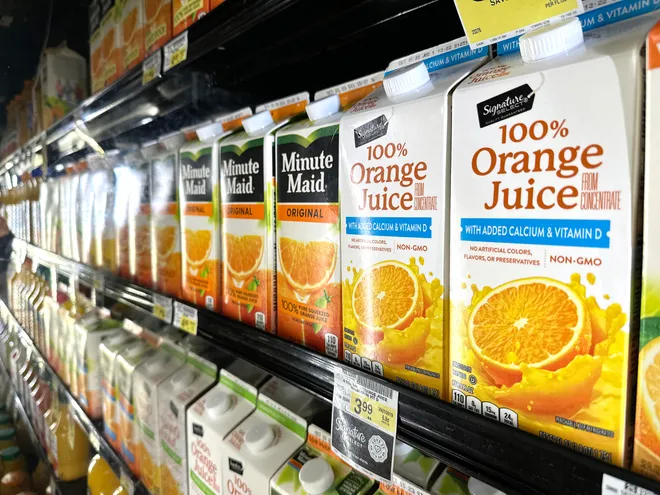You're likely paying way more for orange juice: Here's why, and what's being done about it
The price of orange juice continues to rise due to a disease costing citrus growers millions of dollars, according to federal government officials.
Citrus greening, also known as Huanglongbing (HLB), is the culprit behind the decline and scarcity of oranges, the U.S. Department of Agriculture (USDA) said. While initially only present in Florida, the disease has since spread to parts of Texas and California.
"HLB is the most serious threat to the U.S. citrus industry in history," according to the USDA.
In June 2024, orange juice cost $4.26 per 16 ounces, which is two dollars more than it was in June 2020 ($2.36), the USDA's data shows.
“Citrus production in the United States [is a] pretty dire situation right now,” Daniel Munch, an economist at the American Farm Bureau Federation, told CNBC. “When you have a lack of supply that’s unable to meet demand, prices for consumers shoot up.”

What is citrus greening?
Citrus greening is a disease caused by a bacteria called Liberibacter that most likely originated in Asia before the 1900s, and has since spread throughout the world in many citrus-growing areas, the USDA said.
In countries where HLB is endemic, different citrus trees, such as "sweet orange," begin to decline within 3 to 4 years after planting. This results in "reduced fruit crop and fruit quality," according to the USDA.
Citrus greening was first detected in 2005 in Florida. The disease had been identified in most of the citrus-growing counties in the state by 2008.
"Despite intense efforts, citrus greening now threatens the survival of Florida citrus, has a toehold in other citrus areas, and poses a threat to the entire U.S. citrus industry," the USDA said.
What is being done to control citrus greening?
Researchers with the USDA's Agricultural Research Service (ASR) are continuing to look into the problem, including the disease's pathogen, host, and insect vector, the federal agency said.
"We are making great progress in not only understanding how citrus greening infiltrates healthy citrus trees, but how to protect these trees from the disease," the USDA said. "Our goal is to overcome citrus greening and ensure the U.S. citrus industry can provide consumers with tasty, high-quality citrus fruits for years to come."
Another advancement made by the researchers includes the use of dogs to detect citrus diseases. A team of researchers trained 10 dogs to detect citrus greening and three dogs to detect citrus canker, another bacterial disease that affects citrus trees. The experiment had accuracy rates above 99.97%, according to the USDA.
The Animal & Plant Health Inspection Service plans on deploying trained dogs over the next two years and is working with dog training companies to commercialize this service. Using trained dogs is the only available way to quickly detect citrus greening before visible symptoms, the USDA said.
Disclaimer: The copyright of this article belongs to the original author. Reposting this article is solely for the purpose of information dissemination and does not constitute any investment advice. If there is any infringement, please contact us immediately. We will make corrections or deletions as necessary. Thank you.







